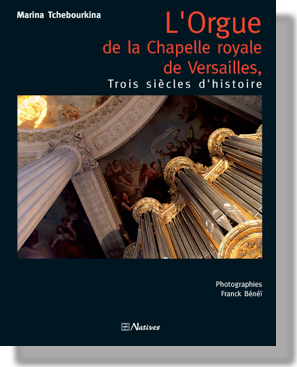Marina TchebourkinaMarina Tchebourkina Марина Чебуркина
Organiste concertiste internationale – Musicologue International concert Organist – Musicologist Международный концертный исполнитель (орган) — Музыковед

L’Orgue de la Chapelle royale de Versailles, Trois siècles d’histoire
par Marina Tchebourkina
Photos : Franck Bénéï
Texte (langue : français) ; 50 photos originales ; 30 documents (manuscrits et sources figurées) en fac-similés.
Couverture rigide avec jaquette ; impression offset ; emballage individuel sous film plastique.
Paris : Natives, 2010. — 256 p.
ISBN-13 : 978-2-911662-09-6
Prix public : 45 € TTC
Acheter
À travers les documents uniques liés à la construction et les restaurations de l’orgue de la cinquième chapelle du château de Versailles, Marina Tchebourkina retrace l’histoire de l’instrument royal, de sa création à nos jours. Son but principal est de « retrouver » la composition initiale de l’orgue construit à la fin du règne de Louis XIV. Elle s’attache par ailleurs à connaître le prix total de l’instrument et les détails de la répartition du marché entre les deux facteurs, Robert Clicquot and Julien Tribuot, — ainsi que les dates exactes de la construction de l’orgue, celle de sa première mise en service et le nom de l’organiste qui le toucha officiellement pour la première fois.
L’auteur fait découvrir le contexte tumultueux de la construction de l’orgue de la cinquième chapelle Royale et met en évidence l’existence au château de Versailles, au temps de Louis XIV, de deux instruments différents dont Robert Clicquot, facteur d’orgues du Roy, était co-créateur : l’orgue de la troisième chapelle (1679–1681 ; Étienne Énocq et Robert Clicquot) et celui de la cinquième (1709–1710 ; Robert Clicquot et Julien Tribuot).
Cette découverte ouvre sur une révélation d’un nombre de confusions et légendes non fondées, voire erreurs historiques, qui jalonnent le passé de l’orgue du château de Versailles jusqu’à nos jours. En voici une : la composition actuelle (1995 ; Bertrand Cattiaux et Jean-Loup Boisseau) ne correspond pas tout à fait à celle dont témoignent les documents historiques…
Accompagnée des fac-similés, riche de découvertes inédites, cette monographie se lit comme un véritable roman policier, tandis que les photos créent une ambiance… presque sonore !
The Organ of the Royal Chapel of Versailles, Three centuries of history
by Marina Tchebourkina
Photos: Franck Bénéï
Text (language: French); 50 original photos; 30 facsimiles (manuscripts and figurative sources).
Hardcover with dust jacket; offset printing; individually wrapped in plastic film.
Paris : Natives, 2010. — 256 p.
ISBN-13 : 978-2-911662-09-6
Public price: 45 €
Buy
Throughout the unique documents related to the construction and restorations of the organ of the fifth chapel of the Palace of Versailles, Marina Tchebourkina traces the history of the royal instrument, from its creation to nowadays. Her main purpose is to “find” the initial Organ Disposition (organ stoplist with some specifications) of the instrument built at the end of the reign of Louis XIV. She also seeks to know the total price of the instrument and details of the deal shared between two organ builders, Robert Clicquot and Julien Tribuot, as well as the exact dates of the erection of the organ, the date of its first official putting into service and the name of the organist who officially played it for the first time.
The author reveals the tumultuous context in which the organ of the fifth Royal Chapel was constructed. She puts in evidence the existence, at the Palace of Versailles under Louis XIV, of two different instruments for which Robert Clicquot, Royal organ builder, was co-creator: the organ of the third (1679–1681; Étienne Énocq and Robert Clicquot) and the organ of the fifth (1709–1710; Robert Clicquot and Julien Tribuot) Royal Chapels.
This discovery opens onto revelation of a number of confusions, unsubstantiated legends and even historical errors which mark the past of the organ of Versailles till today. Here is one of them: the current Organ Disposition (1995; Bertrand Cattiaux and Jean-Loup Boisseau) doesn’t really correspond to that reflected by historical documents…
Accompanied by facsimiles, rich in unexpected discoveries, this monograph could be read as a true detective story, while the photos create an atmosphere proufondly poetic and… really musical!
Марина Чебуркина
Орган Королевской капеллы Версаля, Три века истории
Фотографии : Франк Бенеи
Текст (язык: французский); 50 оригинальных фотографий; 30 факсимиле (рукописи и изобразительные источники).
Твёрдый переплёт с суперобложкой; печать офсетная; упаковка индивидуальная полиэтиленовая.
Paris : Natives, 2010. — 256 p.
ISBN-13 : 978-2-911662-09-6
Цена: 45 евро
Купить
Анализируя уникальные исторические документы, связанные со строительством и реставрациями органа пятой капеллы Версальского дворца, Марина Чебуркина прослеживает историю королевского инструмента с момента его создания до сегодняшнего дня. Её главная цель — «найти» изначальную диспозицию органа, построенного в последние годы царствования Людовика XIV. Её также интересуют стоимость инструмента и детали распределения сделки между двумя органными мастерами, Робером Клико и Жюльеном Трибюо, — как и точные даты строительства органа, день его официальной «инаугурации» и имя органиста, который впервые прикоснулся к нему во время этой торжественной церемонии.
Автор воссоздаёт бурную атмосферу сооружения органа пятой Королевской капеллы. Он выявляет существование в Версальском дворце в эпоху Людовика XIV двух разных инструментов, по отношению к которым Роберт Клико, королевский органостроитель, выступает в качестве соавтора. Это органы третьей (1679–1681; Этьенн Энок и Робер Клико) и пятой (1709–1710; Робер Клико и Жюльен Трибюо) Королевских капелл.
Данное открытие позволяет автору развеять некоторые необоснованные легенды и опровергнуть ряд исторических ошибок, которыми отмечено прошлое версальского органа вплоть до последнего времени. Вот одна из них: нынешняя органная диспозиция (1995; Б. Каттьо и Ж.-Л. Буассо) не вполне соответствует той, о существовании которой свидетельствуют исторические документы…
Настоящая монография, изобилующая неожиданными открытиями, которые подтверждаются приводимыми здесь же факсимиле, читается как настоящий детектив, в то время как фотографии создают сопровождение… поистине музыкальное!